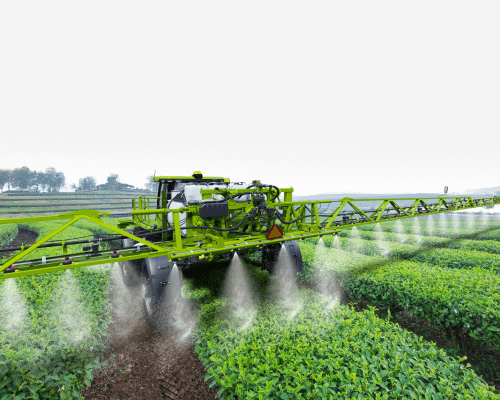In an interview with Acres USA (titled “A Toxic Technology”), Claire Robinson, editor at GMWatch and co-author of the book GMO Myths and Truths discusses the adverse health risks and negative impact associated with genetically modified (GM) crops. In her book, Robinson and her co-authors use scientific and other documented evidence to dispute and disprove claims that GM crops offer higher yields and better nutrition; are safe for health and the environment; reduce agrochemical use; and are needed to feed the world’s growing population. The evidence presented in ‘GMO Myths and Truths’ points to genetic engineering technology’s many hazards, risks, and limitations. In this blog post, we discuss the effects of GMOs on modern agriculture and human health, the future of GM crops and summarise some of the key points made by Claire on this controversial topic.
GM crops definition
Genetic modification is a technology that involves inserting DNA into an organism’s genome. Genetically modified (GM) crops are derived from organisms whose genetic material (DNA) has been modified in a way that does not occur naturally. Introducing a new genetic trait that may not have been associated with the organism previously may impact the way the organism interacts with its environment, the way it grows, propagates or acts as a food source for other organisms.
GM crop examples
The two main types of GM crops available today are Bt insecticidal crops and herbicide-tolerant crops.
Robinson points out some of the potential problems with each:
- Bt insecticidal crops: You’re consuming an insecticidal toxin that has never been tested for toxicity to humans. Animal feeding studies have shown an effect on the mammalian immune system.
- Herbicide-tolerant crops: Engineered to tolerate glyphosate, a probable human carcinogen. Low amounts of this herbicide have been shown to cause non-alcoholic fatty liver disease in rats.
Common GM crops in South Africa
It’s estimated that GMO crops cover more than 2,3 million hectares in South Africa. The country has established three commercially grown GMO commodities:
- Cotton, the first GM crop to be approved in South Africa (100% of locally cultivated cotton is GM-approved)
- Maize (85% of locally grown maize is GM-approved)
- Soya beans (95% of locally grown soya beans are GM-approved)
Worldwide, GM crops such as potatoes, soya beans, squash, maize, canola, alfalfa, cotton, papaya and sugar beets are becoming commonplace. More than 60% of foods in the USA already contain GM traces (if we include the addition of GM ingredients such as canola oil, corn syrup and soya beans to processed foods).
What are GM crops used for?
Growing genetically engineered crops is used in food production mainly to breed plants for herbicide tolerance and resistance to insects.
What are the benefits of GM crops?
The scientific advantages of GMOs include:
- Less frequent application of pesticides
- More rapid plant growth
- Increased food supply at reduced cost
- Creating foods with a longer shelf life
- Crops are better able to withstand climate change elements such as drought
Do GMOs increase yields?
Robinson says there is no evidence that any GM crop consistently increases yields. “Even the USDA and the National Academies of Science concluded that there was no evidence that GM crops actually increased yields,” she said. In some cases, operational yields may increase, meaning that the farmer doesn’t lose as much of their crop to pests. However, pests are becoming increasingly resistant to the Bt toxins found in Bt crops.
GM crops certainly have their pros and cons, but we think there’s a better way to build natural insect and disease resistance and gain higher-quality yields.
What’s the difference between eating GM crops and non-GM crops?
Genetic engineering causes major changes in the crop’s genome, which means that we are facing a complete unknown. We could even be creating unexpected toxins or allergens. We have to ask ourselves: could today’s increases in food allergies be related to GM crop consumption? A growing number of health professionals are prescribing non-GMO diets to their patients for that reason and are seeing some positive results.
Bt: toxin or natural insecticide?
One of the main types of GM crops available today is Bacillus thuringiensis (Bt) insecticidal crops. Bt bacteria have natural insecticidal abilities, making them an important pest control tool for nearly a century. However, engineering Bt genes into major crops (through genetic modification) has been controversial.
Robinson says that the Bt toxin engineered into GM crops is “totally different from the natural Bt toxin that is sprayed by both organic and conventional farmers.” The GM Bt toxin is a protein different in structure and function to organic Bt. This means that it also has different (and potentially dangerous) health effects.
Some of the key differences between natural Bt and GM Bt:
- Natural Bt breaks down in daylight (within hours), so it’s unlikely that a consumer will come into contact with the toxin
- In GM crops, Bt toxins are ‘pre-activated’ and present in every cell (not just on the surfaces of the plant), so the consumer will actually be eating them
GM crops are not acute toxins; therefore, studies aren’t accurate
Robinson points out that many studies on the effects of animals (usually lab rats) consuming GM food are simply too short. She argues that a valid study would need to “produce a huge amount of evidence, and also follow those animals throughout their whole lifetimes before you could conclude that an effect is not relevant or biologically significant.” This “kind of deception” has often been used to dismiss the adverse effects of the GM diet. Yet these short studies on small populations will not show dramatic effects because GM crops are not acute toxins. Robinson compares GM food to cigarettes: “You don’t smoke one or two cigarettes and fall down dead. It takes time.”
Most GM crops end up in animal feed, where they’re fed to farm livestock. In commercial animal farming, livestock is normally slaughtered at a relatively young age. The impact of this is that the effects of feeding livestock GM food are not always immediately obvious to the farmer. That being said, Robinson has come across several farmers who have told her that they notice ill effects when feeding their herds GM feed. This could be due to the GM crop itself, the pesticides it’s grown with, or a combination of both.
Robinson tells of a Danish farmer, Ib Pederson, who didn’t even know about GM feed when his pigs first started showing problems like diarrhoea, stomach ulcers and failure to thrive. He decided to source non-GM feed for his pigs and, within a couple of weeks, the animals stopped showing these problems, leading him to become convinced that GM animal feed has harmful effects. To test this theory, he went back to using GM feed… and the problems came back.
Robinson said: “I think that farmers should do their utmost to grow non-GM feed themselves to feed their animals.”
And what about GM crops’ health risks for humans?
Robinson cites several studies that found that the level of pesticides in people’s urine disappeared within a very short time after they switched to an organic diet. “For that reason alone, I think it’s very important to seek out an organic diet, if you can, particularly if you or your family have health issues.”
Through her years of research, Robinson has found evidence of GMOs having a negative impact on the environment, animals and humans.
What’s the solution to getting high yields with non-GM crops?
One of the main goals of genetic modification is to create crops that are more resilient to pests, weeds and disease. But healthy crops have their own natural resilience. Healthy crops with high yields start from having a healthy soil; one that is self-sustaining and not overly reliant on chemical inputs. Pests and weeds only become a problem when the crops aren’t healthy in the first place – read more on the topic of high brix here.
Robinson believes that sustainable farming methods and modern agroecology – not GM crops – are the best paths for feeding the world’s current and future populations. Robinson said: “What we need to create are resilient, high-yielding, sustainable agricultural systems, rather than trying to genetically tweak crops to give us what we want. We need to look at the system as a whole, look after the soil, use practices like crop rotation to minimise pests and weeds, and pay attention to the things that organic and sustainable farmers have been focusing on for decades and already know about.” Sustainable farming looks at the agricultural system as a whole, returning it to a more natural state that doesn’t require genetic modification to survive and thrive.
Zylem promotes sustainable agriculture by focusing on improving soil health. Get in touch to find out more about the healthy way to transition away from GMOs and feed the world in the long term.
Interested in reading Robinson’s full interview? Visit Acres USA to purchase a back issue and read the original article and other interesting content.

About the Author: Alex Platt
Alex is Business Development Manager at Zylem. He’s inspired by the potential of regenerative farming and takes a special interest in the technology and products that are moving agriculture in a more sustainable direction.

